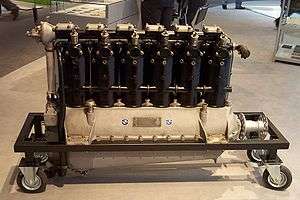BMW IV
| BMW IV | |
|---|---|
 | |
| Preserved BMW IVa | |
| Type | Inline engine |
| Manufacturer | BMW |
| First run | 1919 |
The BMW IV was a six-cylinder, water-cooled inline aircraft engine built in Germany in the 1920s. Power was in the 180 kW (250 hp) range. The IV was also produced under license by Junkers as the L2.
On 17 June 1919 Franz Zeno Diemer flew a DFW F37, powered by a BMW IV engine to an unofficial world record height of 9,760 m (32,021 ft) from Oberwiesenfeld, reaching that altitude in 89 min.[1] Diemer stated at the time, "I could have gone much higher, but I didn't have enough oxygen."
Applications
- Arado SC I
- Albatros L 72
- DFW F37
- Heinkel HD 22
- Heinkel HD 24
- Junkers A 35
- Junkers F 13
- LFG V 59
- LFG V 60
- Rohrbach Ro VII Robbe
Specifications
Data from BMW Type IV description and user manual.[2]
General characteristics
- Type: Six-cylinder inline piston engine
- Bore: 160 mm
- Stroke: 190 mm
- Displacement: 23 L
- Dry weight: 290 kg
Components
- Valvetrain: Overhead camshaft, two valves per cylinder
- Cooling system: Water-cooled
Performance
- Power output: Nominal 230 PS, maximum continuous 250 PS
- Compression ratio: 5.5:1
See also
- Related lists
References
- ↑ "BMW group". Retrieved 27 July 2013.
- ↑ bmw-grouparchiv.de Retrieved: 5 December 2016
External links
| Wikimedia Commons has media related to BMW IV. |
This article is issued from
Wikipedia.
The text is licensed under Creative Commons - Attribution - Sharealike.
Additional terms may apply for the media files.